“Why isn’t every city doing this?” Dave Vella asks as he intently massages a handful of succulent compost from the towering pile freshly deposited onto his vineyard’s gravel thoroughfare. Dressed in jeans and denim shirt, the veteran Grape Manager of Chateau Montelena is about as casual as can be for someone whose vineyard shocked the wine world in 1973 when Parisian judges scored its Chardonnay above all French wines and put Napa Valley on the global map for good.
A native of California’s agricultural Central Valley who says he has watched farmers screw up a lot of land using synthetic fertilizers, Vella isn’t afraid to get down in the dirt. It doesn’t take much prodding by Robert Reed, San Francisco waste management company Recology’s spokesman and the person responsible for bringing a truckload of ”The Mix” that afternoon—along with a French television film crew to document the groundbreaking effects of urban composting on organic farming—to get Vella to spill the beans on the secret ingredient for his award-winning soil.
“The soil microbes flourish on humus,” Vella explains. “If you have soils low in organic matter and humus, you can tell just by the weeds that aren’t growing out there for whatever crop it might be on. Humus is an extremely important part of your soil makeup, and recycling urban food scraps instead of burying them in a landfill is such a non-brainer, as it makes such great compost.” Like a professor trying to make sure his students will at least remember the main thesis of his research, he kicks up the fluffy topsoil with his leather boot. “It’s the black stuff, right under these leaves. If it’s wet you can actually see it.”

Growing up with a gardening mother, I’ve always had an affinity for compost piles in the backyard. As a metropolitan denizen sensitive to human consumption, I have also had a longstanding fascination with material flows in and out of the urban organism, resulting in field trips to transfer stations and recycling facilities. But it wasn’t until I wrote an article about San Francisco’s efforts to achieve zero waste a few years ago when I realized that my adopted hometown was on to something beyond just reducing waste: by making the collection and composting of every disposed scrap of organic matter the linchpin of its garbage policy, it had tapped into a deeper reservoir of transformation through which a city could not only reduce its harmfulness to nature but instead have its urban metabolism mimic the life-supporting ecosystems on which all life on Earth depends, thus restoring—rather than depleting—nature’s innate biocapacity. In other words, San Francisco was becoming more ecocity-like in the way it was treating its resources.
Soil is the solution
My curiosity about how the treatment of municipal organic waste could address a whole range of hot-button issues facing humanity on a global scale had been piqued further when I received an email from Robert Reed in response to my article, with the subject line “Soil is the Solution.” In it, Reed touted the obvious benefits of a robust green bin program, such as the reduction of landfill and the creation of a marketable product: organic fertilizer. But what stopped me in my tracks was his plea to look at the treasure chest of big picture benefits inherent in urban composting, ranging from its potential to conserve water, restore soils, and—the big enchilada—sequester climate change-causing carbon out of the atmosphere.
Citing one of the findings from Rodale Institute’s Farming Systems Trial (or FST)—America’s longest running, side-by-side comparison of organic and chemical agriculture—that the application of food scrap compost to one acre of land might add as much as 12,000 pounds of carbon to the soil in one year (while conventional farming releases 3,700 pounds of it into the atmosphere!), Recology’s Food Rebel explained how the world could offset more than 20 percent of carbon emissions if all cities instituted urban compost collection programs and the organic fertilizer were applied to local farms, especially through the addition of cover crops. “These crops deliver two charges of carbon 14 inches into the soil. The first charge is carbon we preserve in the finished compost. The second charge is carbon the plants pull out of the atmosphere.”
Reed ended his note with the kind of impassioned, bare-knuckled challenge I would come to love and expect from him. “Sven, ‘Soil is the Solution’ might be the most important environmental story you’ll ever write. It is part of the solution to our environmental challenges. The story belongs on the front of the New York Times and on 60 Minutes.” No pressure there, Robert.
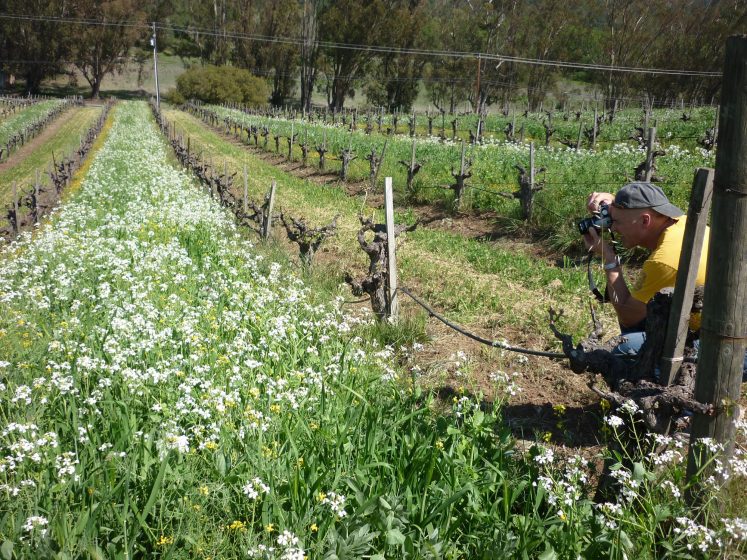
Since that first email exchange with Reed, trips like the one to Chateau Montelena to document the various stages of the city’s organic waste on its way back to residents’ dinner tables have become regular events on my travel calendar. In the past two years alone, I’ve witnessed what used to be dirty napkins, banana peels, and greasy take-out boxes discarded from my own kitchen resurface as precious compost on farms and vineyards in the surrounding hinterlands of the San Francisco Bay Area.
I’ve walked 10 acres of diversified salad mix fertilized by SF compost with Paul Wirtz, production manager for Oak Hill Farm in Glen Ellen, CA. I’ve stood in the field next to Nigel Walker, founder and owner of Eatwell Farm, a 105-acre certified organic farm with a thriving CSA program in the Sacramento Valley, as he explained how he had to scale back on “The Mix” because “the fertility was getting too big.” I’ve gotten lost in a sea of shining mustard, stringy bean, and hairy vetch with Ross Cannard of Enterprise Vineyard Management in Sonoma, learning about the extraordinary capacity of cover crops in fixing nitrogen and storing carbon.

A lot of these visits have been arranged by Bob Shaffer, a Hawaii-based agronomist whom Reed connected me with. Shaffer works as a composting consultant for farms and vineyards across the Western United States and has become a pivotal liaison between Recology and the rising number of growers in search of just the right kind of urban compost mix for their respective soils, micro-climates, and crop rotations. During our initial phone conversation, this living, breathing encyclopedia of soil recapped for me how the high density of protein, oils, complex carbohydrates, and minerals inherent in recycled food provides soil microbes with the nutrition essential for creating Dave Vella and his fellow carbon farmers’ beloved humus. He also pointed out the heavy price humanity is paying for the temporary convenience of the chemical fertilizers used in conventional farming.
“Letting all the carbon that’s supposed to be in our soils go up into the air is causing us not only environmental pollution and the threat of atmospheric warming, but it’s devastating our ability to produce healthy crops. If we keep wasting our nutrients like we have for the past fifty plus years, not only are we filling up our landfills, which we don’t have any room for, and poisoning ourselves with methane, which is a potent greenhouse gas, but we’re not getting the most precious thing that we raise—high mineral value food—back into the soil where it belongs. Now that’s a full-blown crisis.”

The good news, according to Shaffer, is that there is a simple, inexpensive, and effective way to revive the broken cycle, rooted in three basic areas of carbon-based, biological farming. “If we want to feed our soils again, we need to manage organic matter, we need to manage minerals, and we need to manage tillage. By recognizing the incredible synergism at work between compost, cover crops, and mulch, we can grow large volumes of organic matter and return it to the soil.”
Nothing but a bug’s life.
Just how simple and effective this is in practice would come into focus for me a few weeks later, when I was invited to tour some of the farms Shaffer had been working with outside the small town of Sonoma, 50 miles north of San Francisco. We met at Fowler Creek, where Ross Cannard and his partners are experimenting with cover crops as nutrient producers as well as pest control. After a quick introduction to a gaggle of chattering hens (that have made a name for themselves by laying a variety of beautifully colored eggs for such illustrious restaurants as Chez Panisse in Berkeley and Boulette’s Larder in San Francisco), we quickly found ourselves in the middle of a field of twirling greenery.

“Check out the buckwheat over there, nestled between the bell beans and oats,” Shaffer pointed at the shimmering curtain of white dotting across the lush field of tall grass between two rolling hills. “That’s what you get when you put the compost on the cover crop. If you feed the roots of these plants you allow the microscopic bacteria, fungi, nematodes, and protozoa to accelerate their full food web below ground. Those plants are not only stronger nutrition-wise, but they have built-in disease prevention.”
He bent down to pull up one of the buckwheat blossoms. “See these dark spots clustered around the bud and stem? These aphids have now piled up right here to take advantage of nectar and other pasture juices. By having them over here we’re keeping their more mobile ladybug predators all over the field in large enough numbers to help take care of the crop plants. I know, the fearful mind is thinking, ‘Oh my god, kill all the aphids.’ But no, that would be like killing off all of the mice. You need to have a few mice. Either that, or you have to buy cat food.”

It’s this kind of economic calculus that gives Shaffer his biggest opening for selling a radically different way of farming to a trade he knows and understands to be on the cautious side. “There’s a couple thousand pounds or more of insects that come and die here simply because of this plant,” he reckons. “Now let’s convert that to dollars. That’s 35 percent protein and 12 percent nitrogen in the insect’s body, plus other services that are going on. If you go down to the store right now and buy 2,000 pounds of protein, you’re not gonna like it, it’s gonna cost big money. And you have to haul it and apply it.”
Pulling out his magnifying glass, he motioned for me to take a closer look at the tiny critters. “These guys are doing it on their own, they may as well be Bob’s Bug Manure,” he mused about his de facto business partners. “The bottom line is, you raise cover crops with your high nutrient food scraps, you’re gonna get lots of bugs. And they’re gonna end up as part of the fertility in our soil.”
Talking on eggshells
Still buzzing (pun!) from my “bug’s life” exploration with Shaffer, I returned home to a call from a producer at The PBS News Hour, the nightly newscast on American public television. They were doing a story on San Francisco’s progress in becoming a zero waste city and, after finding my article online, figured I might know a person who could show them first-hand how this whole composting thing works at the beginning of the cycle—in a residence. Seeing that my wife and I had been meticulous separators of all living things in our outbound material flow since SF became the first city in the U.S. to make composting mandatory in 2009, the logical outcome of that conversation was a camera crew in our kitchen a week later.

After whipping up a scrambled egg breakfast and tossing a bunch of egg shells, onion scraps and tea bags in our compost bin for the cameraman, we got to share our personal experience of recycling food scraps with PBS reporter Spencer Michels. We went from the technical (kitchen bin is lined with either bio produce bags from our local food coop or just compostable paper bags and wraps from delis and bakeries) to the educational (composting at home is not yucky at all—the exact opposite, by keeping food out of your trash you are keeping your source of potential odor easily identified and separated) to the political (we don’t care whether we’re 70 percent or 80 percent of the way toward our zero waste goal as long as we are getting closer) to the philosophical (composting is fun, engages us as citizens with a stake in our city’s future, and connects a daily routine with the Earth’s ecosystems we depend and thrive on), before finishing with a dramatic live action shot of me depositing the precious scraps in the green bin that serves our multi-unit building.
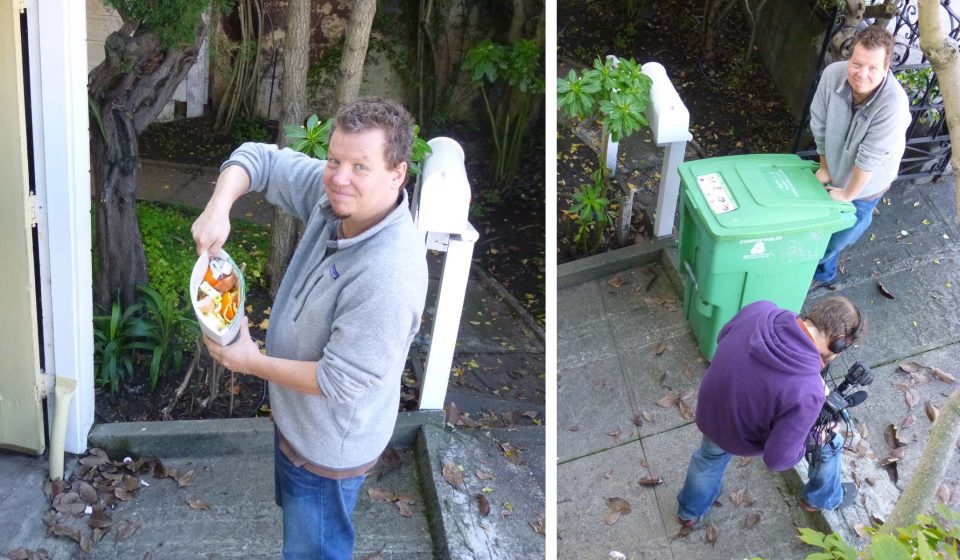
Speaking of getting closer, now that I had seen with my own eyes the economic and environmental value of urban compost and shared with a major news network how eminently achievable it is to set up a city-wide green bin program, I was curious as to why it hadn’t yet become more commonly instituted in municipalities across the country, and the globe. While San Francisco is now collecting 600 tons of compostables every day (219,000 tons per year), the EPA’s latest Sustainable Materials Management Report shows only a slight overall increase of food composting in the United States, from a total of 1.84 million tons in 2013 (5.0 percent) to 1.94 million tons in 2014 (5.1 percent). This means not only that 95 percent of uneaten American food is still being thrown away, but that San Francisco alone is responsible for almost one out of every ten tons of what small percentage does get composted.
The bottleneck, I thought, must surely be in the one link of the organics recycling chain I had not yet inspected more thoroughly: the composting facility. I remembered my mom’s warnings of yore to refrain from tossing anything besides fruit and veggie peels or coffee grounds on her compost pile, and it occurred to me that perhaps the pizza cartons and chicken bones Recology was encouraging us to add to our green bins were responsible for making the composting process too complex and prohibitively expensive for most other municipalities to replicate.
There was only one way to find out, so the next time I was riding my bike past Recology’s headquarters near San Francisco Bay, I stopped in to ask Robert Reed about their flagship composting operation, Jepson Prairie Organics. “Funny you should ask,” he said as I was peeling the tangerine he handed me as a welcome-to-his-office gift. “I’ve got thirteen visitors from agricultural cooperatives and food companies in France coming to see Jepson Prairie. What are you doing next Tuesday?”
Bringing the Coquille back to the farm
We got to the town of Vacaville about half way between San Francisco and Sacramento at around 9:15 am. Reed, who had picked me up in his Prius an hour earlier bearing coffee and apples for breakfast en route, turned onto a straight country road before pulling into what looked like an empty construction lot a few miles ahead. “This is it.” He pointed at a basin of about 50 acres that looked a bit like a quarry, with some trucks, equipment, and a bunch of piles of dirt. “The French aren’t here yet, so go ahead and check out some of the finished compost piles by the office.” I wandered behind the unassuming single story building and discovered my first big piles of virgin San Francisco Mix.

“That’s our premium compost blend of food scraps and yard trimmings. Took just about 30 days to cure and has another 15 to 30 days to go until it’s a mature, finished product.” Reed had sneaked up behind me, joined in neon-yellow Recology safety vests by a middle-aged gentleman with a robust frame and a healthy farmer’s tan. “Sven, I want you to meet Greg Pryor. Greg oversees all eight of our compost facilities and has unique insights into the art of making fine urban compost and its benefits for topsoil. Lucky for us, he will lead our tour today.” Pryor was about to launch into a story about how he was first tasked in 1994 by Recology’s previous incarnation to set up an experimental compost collection program when we heard two vans pull up. “That must be our French delegation,” Reed interjected. “Let’s say bonjours.”
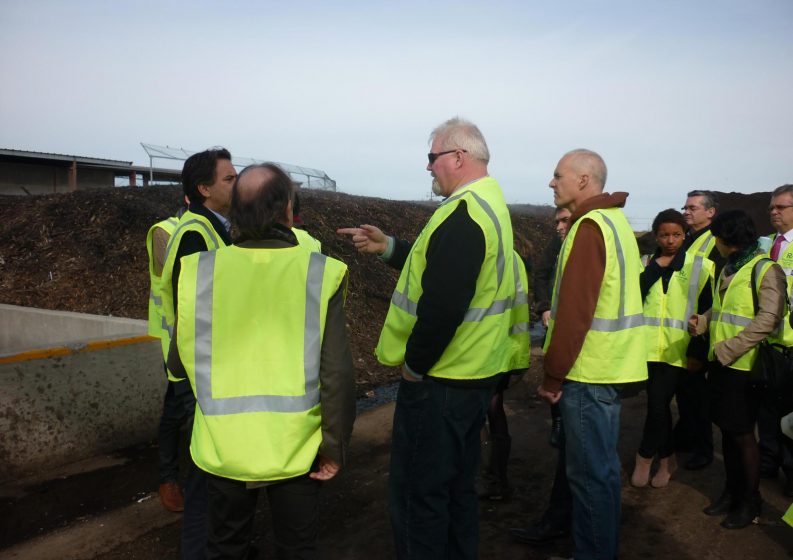
With everyone gathered, Pryor gave us a quick rundown of how the operation had evolved since its early days, adapting to an ever-increasing volume of compost while complying with California’s steadily tightening air quality regulations. “We had to meet specific criteria that quantified emissions from when we received the material, while it’s being processed, while it’s actively composting, to the finished product.” Finding the right technology that would drastically reduce Volatile Organic Compounds (also called VOC) while also keeping things competitive with the (too) low cost of dumping everything in landfill led Jepson Prairie from giant Ag Bags to Aerated Static Piles (or ASP) to their current state-of-the-art negative ASP. “Rather than forcing air up through the compost and blowing all the emissions into the atmosphere the way we used to do it with the positive ASP, we’re now drawing air down where it’s collected in a series of ducts and pipes and then exhausted out through a biofilter. The negative ASP is giving us a 97 percent destruction of VOC.”

Filled with some good technical nutrients, everyone was ready to smell the dirt (though mostly in the metaphorical sense of the word, as the early morning arrival of the compost trucks coupled with the rapid breakdown of materials through the teamwork of bacteria, fungi, and lots of air renders the place largely odorless during the day). We walked the facility in sort of a “reverse rot” direction, from the pristine finished piles near the office, to the in-progress aerated static piles transected by a geometrically sculpted system of aluminum piping, to the beginning of the chain where the grinder, trommel, and conveyor belt were rattling along, doing the busy work of cutting yard trimmings to size and picking unwanted objects from the coveted organics nectar.

Pryor tells us that they process about 375 tons of finished product every day, sold to over 350 farms, vineyards, orchards, and landscapers in the region. “We have four standard blends, but a lot of our customers prefer their compost made to order with custom nutrients and minerals. Everyone has different crops and conditions, so the personalized aspect is really what makes our mixes so popular.” The biggest challenge, other than removing non-compostable items (and educating citizens to separate at the source), is that the demand for good compost is growing so fast, while most facilities like Jepson Prairie are already at capacity. According to Pryor, getting the land and permits to run a composting operation in California is prohibitively expensive, with little incentive by the powerful chemical fertilizer industry to lobby the state government to streamline and speed up the costly regulatory red tape.

So there’s one of our bottlenecks in the quest to get more of our food scraps composted. The good news that I gleaned from both Pryor and in my conversations with Bob Shaffer is that a growing number of the bigger players in the agriculture business are currently experimenting with compost, which, ironically, is contributing to the supply shortage. This, of course, makes perfect sense, as depleted soils aren’t only bad for the planet, but—as with everything else when previously externalized ecological bills come due—their ever-diminishing returns will ultimately impact the bottom line. Synthetic fertilizers worked great for a while to squeeze everything out of existing soils, but at some point you have to replenish them with nutrients if you want to keep growing and selling food that actually feeds. As more industrial farms realize the value of this product and how technologically advanced the composting process has become, the hope is that the labyrinth of archaic regulations can be disentangled more quickly.

“You want to know a secret?” Robert Reed interrupts our silent sniffing and caressing of the various piles of compost with a one word epiphany that remind me of Mr. McGuire in The Graduate.
“Shellfish.”
I could tell by the ensuing murmur that the French visitors did not want to miss what was obviously going to be a teachable moment that day.
“You know all the crabs and mussels that get fished and eaten at Fisherman’s Wharf in San Francisco?” he asks rhetorically. “The shells contain chitin, a great source of nitrogen, phosphorous, calcium, and magnesium. It’s a superb cleansing agent and exactly the kind of ingredient that makes our compost so rich. So when people throw these shells in the trash after their crab feast, it’s like they’re throwing away gold without even knowing it. That’s why education is such an important component of composting. ”
Reed turns to one of the bilingual members of the group. “What’s ‘shell’ in French?” Someone yells “Coquille” and Recology’s intrepid resource recognition slam poet improvises the most memorable line of the day.
“We have to bring the Coquille to the farm!”
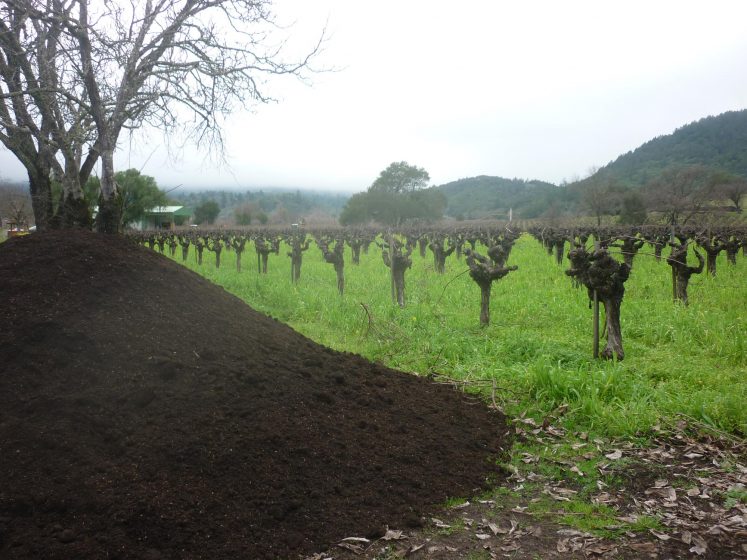
Since returning home from that afternoon, I’ve been feeling pretty optimistic about the prospects of looping our cities into the natural systems that have sustained us since the beginning of the agricultural age. If we can reactivate some of the wisdom and practices that worked for us before the industrial revolution while recalibrating the many insights and advances we’ve gained since then to align with the Earth’s naturally self-sustaining processes, the vision of cities becoming part of the solution, instead of being major problems, is not that far-fetched.
It’s true, there’s a long way to go. But I’m encouraged that there are now over 150 communities (and growing!) across the United States with source separated organics programs, spreading across a total of 16 states. I’m thrilled that over 100,000 New Yorkers are now composting their coffee cups and bagel wrappers. I’m heartened that communities from British Columbia to Vermont are getting serious about keeping their organic assets invested in the natural loop. And fresh off the presses, I am ecstatic that Paris, which—like most of France—had thought until recently that it was prudent to just burn all its resources—just announced its new compost collection program for the 2nd and 12th arrondissements, with the intention to service the whole city soon.
Now that’s what I call bringing the Coquille back to the farm.
Sven Eberlein
Oakland

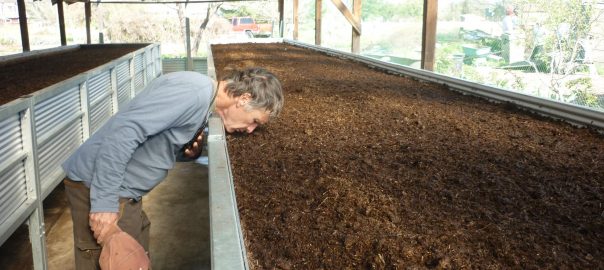





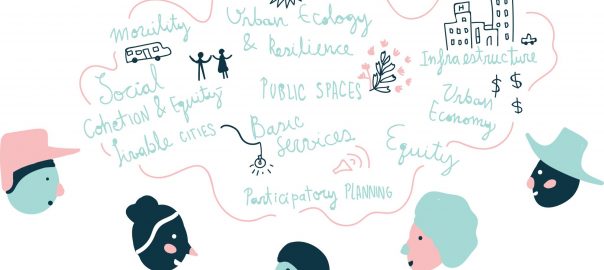



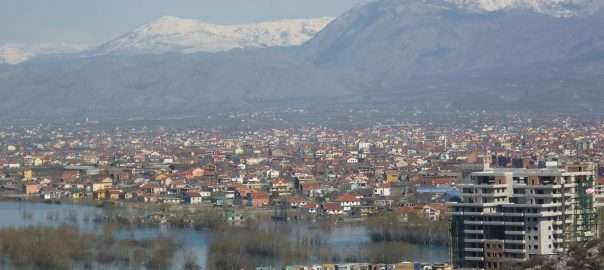
Thank you for reading, Pete. I hope that this story can inspire other municipalities to look into and get serious about composting. Once you do it, it becomes hard to believe how your city could ever have thrown all those valuable nutrients into a big hole in the ground or incinerate them.
Hi Albertus, great to see you here and glad you’re digging my compost piles. Hope all is well!
Nice article Sven! Great to catch up with you again!!
Great article. A positive boost that hopefully others will take up. Thanks regards Pete